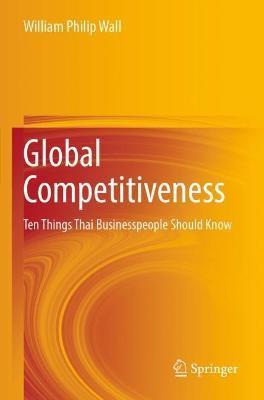Global Competitiveness: Ten Things Thai Businesspeople Should Know

Global Competitiveness: Ten Things Thai Businesspeople Should Know
Chapter 1: Global Competition - The Battlefield 1.1 Scope of Business Competition 1.2 Types of Competition 1.3 Forms of Competition 1.3.1 Perfect Competition 1.3.2 Monopoly Competition 1.3.3 Monopolistic Competition 1.3.4 Oligopoly Competition Chapter 2: Marketing - Position Yourself 2.1 Definitions of marketing 2.2 Practicing Marketing 2.3 Applying the 4p's of Marketing 2.3.1 Product 2.3.2 Price 2.3.3 Place 2.3.4 Promotion 2.4 Positioning Yourself in the Business Market 2.4.1 Positioning Strategies 2.4.2 Developing a position statement 2.4.3 Identifying Current Market Position 2.4.4 Analyzing Competitor Positioning 2.4.5 Developing a Unique Position Chapter 3: Innovate - Generate and Evaluate 3.1 Business Innovation 3.2 Applying the Four Types of Innovation 3.2.1 Incremental Innovation 3.2.2 Disruptive Innovation 3.2.3 Architectural Innovation 3.2.4 Radical Innovation3.3 The Business Innovation Process 3.3.1 Step 1: Idea Generation and Mobilization 3.3.2 Step 2: Advocacy and Screening 3.3.3 Step 3: Experimentation 3.3.4 Step 4: Commercialization 3.3.5 Step 5: Diffusion and Implementation Chapter 4: Using Information - Leverage Resource 4.1 Information as a Resource 4.2 Exiting Forms of Information 4.3 Basic Sources of Information 4.4 Leverage Business Information/Knowledge to create Value 4.4.1 Leveraging Business Information 4.4.2 Information in Driving Revenue 4.4.3 Improving Operational Efficiency 4.4.4 Improving Customer Focus 4.4.5 Gaining Competitive Advantage 4.4.6 Setting Realistic Goals Chapter 5: Technology - Upgrade 5.1 Technology in Business 5.2 Steps to Follow When Upgrading Your Business Technology 5.2.1 Step 1: Identify Technological Loopholes 5.2.2 Step 3: Pilot Operation 5.2.3 Step 3: Communication Plan 5.2.4 Step 4: Training 5.2.5 Step 5: Preparing Infrastructure 5.2.6 Step 6: Implementation and Support 5.2.7 Step 7: Performing Upgrade Review 5.3 Benefits of Upgrading Technology in Business 5.3.1 Increased Productivity 5.3.2 Security of Data 5.3.3 Attracting More Customers 5.3.4 Cost Minimization 5.3.5 Solving Problems Chapter 6: Human Resources/Cross-Cultural Communication 6.1 Human Resource Development 6.2 Cross-Cultural Communication Awareness 6.3 Focusing HRM Communication towards Business Missions 6.3.1 Strategic Communication 6.3.2 Communicating Human Resources Benefits and Risks6.3.3 Functional Implementation 6.4 Creating Effective Communication within the Organization 6.5 Human Resource as a Business Asset 6.5.1 Human Capital
PRP: 511.41 Lei
Acesta este Pretul Recomandat de Producator. Pretul de vanzare al produsului este afisat mai jos.
460.27Lei
460.27Lei
511.41 LeiLivrare in 2-4 saptamani
Descrierea produsului
Chapter 1: Global Competition - The Battlefield 1.1 Scope of Business Competition 1.2 Types of Competition 1.3 Forms of Competition 1.3.1 Perfect Competition 1.3.2 Monopoly Competition 1.3.3 Monopolistic Competition 1.3.4 Oligopoly Competition Chapter 2: Marketing - Position Yourself 2.1 Definitions of marketing 2.2 Practicing Marketing 2.3 Applying the 4p's of Marketing 2.3.1 Product 2.3.2 Price 2.3.3 Place 2.3.4 Promotion 2.4 Positioning Yourself in the Business Market 2.4.1 Positioning Strategies 2.4.2 Developing a position statement 2.4.3 Identifying Current Market Position 2.4.4 Analyzing Competitor Positioning 2.4.5 Developing a Unique Position Chapter 3: Innovate - Generate and Evaluate 3.1 Business Innovation 3.2 Applying the Four Types of Innovation 3.2.1 Incremental Innovation 3.2.2 Disruptive Innovation 3.2.3 Architectural Innovation 3.2.4 Radical Innovation3.3 The Business Innovation Process 3.3.1 Step 1: Idea Generation and Mobilization 3.3.2 Step 2: Advocacy and Screening 3.3.3 Step 3: Experimentation 3.3.4 Step 4: Commercialization 3.3.5 Step 5: Diffusion and Implementation Chapter 4: Using Information - Leverage Resource 4.1 Information as a Resource 4.2 Exiting Forms of Information 4.3 Basic Sources of Information 4.4 Leverage Business Information/Knowledge to create Value 4.4.1 Leveraging Business Information 4.4.2 Information in Driving Revenue 4.4.3 Improving Operational Efficiency 4.4.4 Improving Customer Focus 4.4.5 Gaining Competitive Advantage 4.4.6 Setting Realistic Goals Chapter 5: Technology - Upgrade 5.1 Technology in Business 5.2 Steps to Follow When Upgrading Your Business Technology 5.2.1 Step 1: Identify Technological Loopholes 5.2.2 Step 3: Pilot Operation 5.2.3 Step 3: Communication Plan 5.2.4 Step 4: Training 5.2.5 Step 5: Preparing Infrastructure 5.2.6 Step 6: Implementation and Support 5.2.7 Step 7: Performing Upgrade Review 5.3 Benefits of Upgrading Technology in Business 5.3.1 Increased Productivity 5.3.2 Security of Data 5.3.3 Attracting More Customers 5.3.4 Cost Minimization 5.3.5 Solving Problems Chapter 6: Human Resources/Cross-Cultural Communication 6.1 Human Resource Development 6.2 Cross-Cultural Communication Awareness 6.3 Focusing HRM Communication towards Business Missions 6.3.1 Strategic Communication 6.3.2 Communicating Human Resources Benefits and Risks6.3.3 Functional Implementation 6.4 Creating Effective Communication within the Organization 6.5 Human Resource as a Business Asset 6.5.1 Human Capital
Detaliile produsului








